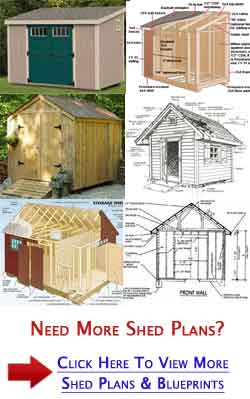 shedramps.com
shedramps.com Introduction: Level Up Your Shed Access with a DIY Aluminum Ramp
Having a shed is great for storage, but getting heavy equipment in and out can be a real pain. Pre-made ramps can be expensive, but building your own aluminum ramp is a cost-effective and customizable solution. This guide will walk you through the process, step-by-step.
Materials and Tools You'll Need
First, gather your supplies. Here's a general list, but you may need to adjust based on the size and capacity of your ramp:
- Aluminum Angle (for the sides and rungs) Determine the length and width based on your shed's door height and the desired ramp length.
- Aluminum Sheet (for a solid surface optional, but recommended for smaller wheeled items)
- Aluminum Welding Wire (if welding) or Aluminum Rivets (if riveting)
- Non-Slip Tape or Coating
- Measuring Tape
- Pencil or Marker
- Safety Glasses
- Work Gloves
- Welding Machine (if welding) OR Drill and Rivet Gun (if riveting)
- Clamps
- Saw (suitable for cutting aluminum)
- File or Deburring Tool
Step 1: Planning and Measurement
Carefully measure the height from the ground to the shed's door threshold. This measurement is crucial for determining the ramp's length. A gentler slope is easier to traverse, so aim for a slope of approximately 1:8 to 1:12 (for every inch of height, the ramp extends 8 to 12 inches in length). Decide on the desired width of the ramp based on what you'll be rolling or driving onto it. This will determine how much aluminum angle you need. Sketch out a detailed plan of your ramp, including all dimensions.
Step 2: Cutting the Aluminum
Using your measurements and saw, cut the aluminum angle to the required lengths for the ramp's sides. Ensure the cuts are straight and precise. Cut additional pieces of aluminum angle for the rungs (if you choose to build ramp without a solid aluminum sheet surface). The number of rungs will depend on the ramp's length and the desired spacing between them. Cut the aluminum sheet if you're making ramp with a solid surface.
Step 3: Assembling the Frame
Clamp the aluminum angle pieces together to form the ramp's frame. Double-check that the frame is square and all angles are correct. If you're welding, carefully weld the corners of the frame. If you're riveting, drill holes through the corners and secure them with rivets. Use sufficient clamps to ensure proper alignment during this process.
Step 4: Adding the Rungs or Solid Surface
If using rungs, evenly space them between the ramp's sides. Clamp each rung in place and either weld or rivet them to the frame. For a solid surface, place the aluminum sheet on top of the frame and secure it with welds or rivets. Ensure that the solid aluminum sheet is secured to each runner/frame support using rivets or welds.
Step 5: Finishing and Safety
Use a file or deburring tool to smooth any sharp edges or burrs on the aluminum. This will prevent injuries and damage to tires or equipment. Apply non-slip tape or a non-slip coating to the ramp's surface to provide traction, especially in wet or icy conditions. Test the ramp with the equipment you plan to use on it to ensure it is stable and can handle the load.
Step 6: Attaching Ramp to Shed (Optional)
If desired, you can add a hinge or securing mechanism to the top of the ramp to attach it to the shed. This will prevent the ramp from shifting or sliding during use. This attachment method will vary depending on the type of shed door and the ramp's design. A simple option is to drill holes through the top of the ramp frame and use bolts to attach it to the shed's door frame.
Conclusion: Enjoy Your New Ramp!
You've successfully built a durable and functional aluminum ramp for your shed. With proper planning and execution, you can save money and customize a ramp to perfectly suit your needs. Remember to always prioritize safety and use caution when working with tools and materials. Now you can easily move your equipment in and out of your shed!
Extruded Aluminum Ramp
 shedramps.com
shedramps.com Extruded Aluminum Ramp
 shedramps.com
shedramps.com Extruded Aluminum Ramp
 shedramps.com
shedramps.com 
 buildyoursheddiy.com
buildyoursheddiy.com  buildyoursheddiy.com
buildyoursheddiy.com  buildyoursheddiy.com
buildyoursheddiy.com  www.storageunitsdublin.com
www.storageunitsdublin.com  www.kostorage.com
www.kostorage.com  www.secondharvestmadison.org
www.secondharvestmadison.org  storagearts.com
storagearts.com  storagearts.com
storagearts.com  storagearts.com
storagearts.com  www.kostorage.com
www.kostorage.com  monroesheddepot.com
monroesheddepot.com  www.gazebocreations.com
www.gazebocreations.com  www.gazebocreations.com
www.gazebocreations.com  www.homedepot.com
www.homedepot.com  facts.net ```html
facts.net ```html  www.freeimages.com
www.freeimages.com  www.mineralienatlas.de
www.mineralienatlas.de  www.apartmentguide.com ```html
www.apartmentguide.com ```html  www.homelandsskyline.lk
www.homelandsskyline.lk  www.alamy.com
www.alamy.com  commons.wvc.edu
commons.wvc.edu  en.wikipedia.org
en.wikipedia.org  www.flickr.com
www.flickr.com  gar.flicksinthegarden.com
gar.flicksinthegarden.com  www.arkaenergy.com
www.arkaenergy.com  www.gardenoid.com
www.gardenoid.com